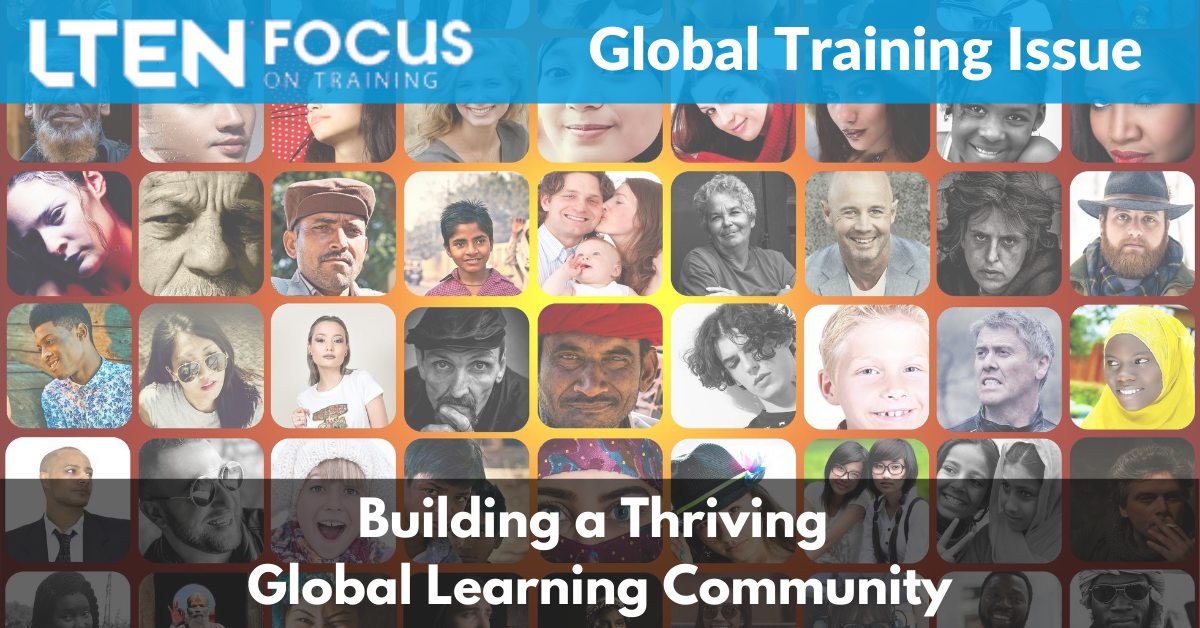
Building a Thriving Global Learning Community
FEATURE STORY – By George Schmidt and Kerstin Hartig
There are challenges that L&D teams must address as they transition to a global footprint.
Think back to the last conversation you had with someone from another country. Each of these expressions makes complete sense to a native English speaker, but, to a non-native speaker, they could cause confusion:
- “Put a lid on it.”
- “Kill two birds with one stone.”
- “It’s a double-edged sword.”
Ensuring we understand each other is just one challenge of working globally, which was the subject of a workshop we conducted at LTEN’s 2019 Annual Conference. The workshop, How to Build a Thriving Global Learning & Development (L&D) Community, addressed the key benefits and challenges associated with “going global.” This article summarizes its key outputs.
Introduction
As the global economy evolves, life sciences companies are becoming increasingly global in their mindsets and actions. As a result, L&D teams must work more effectively across markets to achieve business objectives.
For L&D, working globally can offer many benefits, including more efficient use of global platforms, enhanced best practices sharing and more. However, there are challenges that L&D teams must address as they transition to a global footprint. Here is some input on challenges from LTEN members that was shared during the workshop:
- Why L&D should work globally.
- The benefits of a global footprint.
- Outlining key challenges associated with “going global.” Offering some potential solutions.
Why Should L&D Work Globally?
In part, L&D should work globally because it’s becoming a necessity.
Historically, the world’s economy has largely been driven by countries in North America and Europe. Even though North America and Europe have been economic leaders, they have not led the world in terms of population growth. In those terms, Asia, Africa and other regions lead the pack. Now, many nations in those regions are catching up economically. The world’s economic “center of gravity” is shifting.
As these economies develop, pharmaceutical companies are increasingly going to where the markets are (or are rapidly emerging). North American and European markets are still key, but the focus is shifting to nations like the E7 markets of Brazil, China, India, Indonesia, Mexico, Russia and Turkey. The world’s economy is expected to shift significantly in the E7’s favor by 2050.
 As biopharmaceutical companies become more active in emerging markets, they’re increasing their global scale. They’re conducting trials, opening offices and establishing or expanding field forces in those areas.
As biopharmaceutical companies become more active in emerging markets, they’re increasing their global scale. They’re conducting trials, opening offices and establishing or expanding field forces in those areas.
L&D must support needs across these markets. That will become very difficult with an overcentralized approach that fails to properly account for local needs. It would be equally difficult with a fully decentralized approach using local personnel who have weak ties to the home office. A properly designed global community finds the best balance between these extremes.
Benefits of a Global Footprint
Building a global L&D community means structuring an organization so that centralized guidance, standards and community are properly balanced with local attention, autonomy and flexibility.
The overarching goal is to simultaneously:
- Maximize efficiency and effectiveness.
- Safeguard quality.
- Give local professionals the flexibility to meet the needs of their cultures and markets.
Done correctly, building a global L&D community can offer a range of benefits, including:
 Consistent messaging across markets (with appropriate local flexibility).
Consistent messaging across markets (with appropriate local flexibility).- Consistent L&D philosophy and approaches.
- Consistent quality standards and performance metrics.
- A sense of esprit de corps, even across markets.
- More efficient use of suppliers, platforms and technologies.
- Sharing of innovative solutions and best practices.
- Better collaboration and sharing of expertise.
- Better developmental opportunities for L&D team members. For example, a trainer from a smaller country that doesn’t have a full L&D team can go on assignment in another country and learn to be a manager. Such cross-pollination can reduce turnover and increase opportunities for sharing ideas and best practices.
Key challenges include avoiding duplication of work and ensuring training initiatives fit local needs.
Key Challenges Associated with ‘Going Global’
The benefits can be great, but there are challenges. They can be organized into two categories: general and L&D-specific.
General challenges can include:
- Potential for unclear roles and responsibilities. Working across global, regional and affiliate teams can lead to uncertainty about who is responsible for — or should be involved in — understanding needs, prioritizing strategies, developing solutions and implementing training.
- Potential for friction across the matrix (“turf wars”). Given different perspectives and what are often different agendas, matrix teams can struggle to align around a common vision. This can cause disagreements and energy being expended on internal efforts rather than solutions to better drive external engagement.
- Language differences. Any time a team is composed of diverse nationalities speaking multiple languages, it can be difficult to communicate effectively.
- Cultural differences. In different cultures, there are varying degrees to which people are comfortable speaking up, offering different ideas or disagreeing with a potential approach. This can be challenging to navigate in a culturally sensitive manner.
L&D-specific challenges can include:
- Translation. Raw language translations are not that difficult, but translating idioms or expressions effectively is often much harder.
- Localization. To ensure consistency, some level of centralized development is required for many materials. However, they must also be customized for their local markets for local epidemiology, approved treatment options or differences in customer mix. It can be difficult to find the right balance and facilitate efficient customization.
- Duplication of work. Each country will typically need programs that address similar needs. It can be challenging to prevent wasteful duplication of efforts.
- Compliance and approvals. With so many markets — each with different regulations and business approvers — it can be tough to design materials at a global level that meet all the different needs at the affiliate level.
- Version control and updates. Given the need to localize — and to make regular updates with both global and local changes — the number of versions can become quite large and hard to manage.
Addressing the Challenges: Potential Solutions
The workshop attendees decided to focus attention on two key challenges that incorporate many of the issues raised above: 1.) Avoiding duplication of work, and 2.) Ensuring training initiatives fit local needs.
Avoiding Duplication of Work
This is important because each country can end up spending time and money on overlapping programs to meet similar needs, which can waste resources. It also fails to allow sharing of best practices, forcing local teams to independently solve the same problems without the benefit of learning from each other.
One potential solution is for global training leaders to develop templatized materials (though it’s definitely possible to overdo it). Once the materials are handed off to the regions, the local training teams can complete them by inserting localized messaging, information and data points. This helps drive consistency while allowing local flexibility, and it’s far more efficient than creating content from scratch in each region.
Ensuring Training Initiatives Fit Local Needs
 Each market will have different business priorities and needs, so addressing this reality is critical. To do this, global L&D can use an approach similar to the templatization concept described above. For any given program, global L&D can develop a core model that provides a framework, but that’s not “fully baked.” Within that framework, local training teams and suppliers can customize content. This goes beyond simply inserting localized content into templates.
Each market will have different business priorities and needs, so addressing this reality is critical. To do this, global L&D can use an approach similar to the templatization concept described above. For any given program, global L&D can develop a core model that provides a framework, but that’s not “fully baked.” Within that framework, local training teams and suppliers can customize content. This goes beyond simply inserting localized content into templates.
For this technique to work well, local training managers need strong critical thinking skills so they can work strategically with local leaders and global training leads. They must be empowered to properly analyze local needs and adjust global offerings accordingly. They should not just be a team that executes whatever the global leads give them.
There are also a few other points to consider:
- Use a stepwise approach to align on frameworks and models for now with a goal to drive toward one common model globally.
- For global materials and program frameworks, involve local representatives
on the design and development team from the beginning to avoid pitfalls during rollout. Build advisory boards of field-level managers that act as sounding boards during the development process. - Over the long haul, it’s critical to build trust and collaboration among global and local L&D teams. Local managers and global L&D leaders should have monthly teleconferences or virtual meetings, along with an annual in-person meeting when possible.
Conclusion
As the global economy evolves, biopharmaceutical companies are becoming increasingly global in their outlook. L&D teams must adapt and become more global in their mindset, organization and management.
Success requires the right balance of centralized management and local autonomy. When such a balance exists, the global L&D team becomes the guardian of quality on a global basis, as well as a mechanism for sharing best practices and building efficiencies. The local teams can become sources of new ideas while ensuring that local needs are met.
The benefits of going global can be great, but so can the challenges. By keeping some key points in mind and learning from the successes and mistakes of those who’ve done it before, L&D teams can successfully transform themselves into global L&D communities.
Case Study: BMS Transitions to a Global L&D Community
When the BMS L&D team decided to go global, the company was preparing to launch a new immunooncology product. The team would be responsible for training on multiple indications globally. The primary goal was not to save money, but to increase efficiencies, enable the team to get things done faster and prepare for future demands. The team had several key imperatives:
Create and maintain a global learning organization. BMS L&D adopted a stepwise approach rather than launching in every market simultaneously. This enabled the team to get set up in priority markets first and “work the bugs out” before establishing operations in other markets. BMS also focused on recruiting local leads who were very competent in building relationships across geographies and functions.
Convince local management of L&D’s value on an ongoing basis. L&D established a matrix structure with dotted-line reporting to local second-line managers. The L&D leads were accountable for meeting with local senior management on a regular basis to update them on the department’s strategic imperatives and progress against business objectives.
Establish global platforms. It was critical to invest in a best-in-class learning platform that could be highly integrated with other systems and that learners and trainers would want to use.
Maximize opportunities for co-working. L&D made sure to provide its team members with ample opportunities to work, contribute and learn globally. The department offers tours of duty across markets and lets trainers work on global projects together.
Fit programs to local needs. BMS upskilled local training managers in critical thinking. This helped them become real business partners to the local second-line managers. They were given flexibility to adapt global training initiatives (within reasonable limits) to suit local needs.
Reduce duplication of efforts. L&D built a shared repository system for content and materials. It’s easy to reach and includes a proper search function and communicates updates in real time.
George Schmidt is general manager, Salience Learning. Email George at gschmidt@saliencelearning.com. Kerstin Hartig is field training lead, Germany, Bristol- Myers Squibb. Email Kerstin at Kerstin.hartig@bms.com.
Summer 2020









